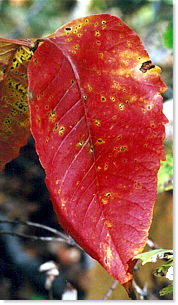
Fall Colours!
| By Johnny Caryopsis | (Click links for more images.) |
 People don't think much about leaves until autumn. Then, for a brief time, we revel in the multitude of colours that emerge from what was previously a plain green background. Of course, there were subtleties of shade and texture in the greenery that surrounded us all summer, but after the first flush of green in the spring, we quickly grow accustomed to the green backdrop of plant leaves and focus our attention elsewhere. The coming flowers or ripening fruits seem to be all that we care about, however small these components may be when compared to the entire, leafy plant. We often see leaves only as a background to set off the more attractive parts of plants.
People don't think much about leaves until autumn. Then, for a brief time, we revel in the multitude of colours that emerge from what was previously a plain green background. Of course, there were subtleties of shade and texture in the greenery that surrounded us all summer, but after the first flush of green in the spring, we quickly grow accustomed to the green backdrop of plant leaves and focus our attention elsewhere. The coming flowers or ripening fruits seem to be all that we care about, however small these components may be when compared to the entire, leafy plant. We often see leaves only as a background to set off the more attractive parts of plants.
 Even Poison Ivy turns colour in the fall.
Even Poison Ivy turns colour in the fall.But when days shorten and grow crisper, leaves come into their own, though it is only in death that they finally attract our attention. As the golds, yellows, reds and browns of autumn emerge we come to realize the diversity of the plants that once made up the summer greenery. Where many different plants or trees grow together, the green background is transformed into a mosaic of individual plants in varying hues. Plants often turn colour "out-of-sync" with their neighbours so that even in single species plantings, they stand apart from the others. For a few short weeks before winter's white coat arrives, Mother Nature shrugs off her dowdy greens, throws fashion sense to the wind and bursts forth with a season ending explosion of colour. And then we get out the rakes!
But what is the cause of our fall splendour you ask? Where do the yellows, golds, reds and browns come from? The complete answers to these questions involves some pretty hefty science, with lots of plant biochemistry and physiology. I don't pretend to fully understand the myriad of processes involved, but I think I've got enough of a handle on it to help you grasp it, too.
But, just in case you're in a hurry, and want it in a nutshell, here's what happens. Read the paragraph below. Otherwise, enjoy the rest of the article.
|
Why Are Plants Green?
Before we get into an explanation of fall colours we need to understand why plants are green in the first place. During the growing season plant leaves appear green to us because they reflect green light. Or more correctly, the chlorophyll inside the leaves reflects green light. Most of the materials that make up a leaf are colourless or clear. Leaves and the cells they are constructed of are mostly water, just like us. Chlorophyll is that miraculous molecule that captures sunlight and allows plants to make their own food, a process called photosynthesis. The energy of sunlight is used to recombine water and carbon dioxide molecules into simple sugars and oxygen: that rather important plant waste product! Chlorophyll molecules absorb, and make use of sunlight from the red and blue ends of the spectrum. They're not good at absorbing green, so this is transmitted or reflected, and bounces to our eyes. Plants are green because they waste green light. Actually, they waste a fair bit of the sunlight that hits them; no plant absorbs all the light hitting it. It's just that more green light is reflected than any other colour, so we see the plant as green. If plants could absorb all the light that hit them, what colour would they be? That's right, black.
Chlorophyll is a pigment. Any substance, regardless of whatever else it does, that influences the colour of another substance is a pigment. Say, for example, you're making Kool-Aid. If you add the sugar to the water first, the water remains clear. Sugar is not a pigment. When you add the contents of the Kool-Aid packet it produces a strong colour in the water. In this instance Kool-Aid is a pigment. Or rather, the food colouring in the Kool-Aid is a pigment. Chlorophyll is a "photosynthetic pigment": a substance involved in the process of making food from light that also produces colour.
Chlorophyll molecules are very large and complex, and (and this is important!) quite unstable when exposed to sunlight. Chlorophyll breaks down rapidly with use, so throughout the growing season plants must continue to produce new chlorophyll. A steady state, where production equals loss, is maintained until the end of summer.
Other Pigments in Plants
Photosynthesis involves an array of photosynthetic pigments, not just chlorophyll. There are, in fact, two kinds of chlorophyll (referred to as "a" & "b"), as well as another class of photosynthetic pigments called carotenoids. These molecules also absorb light for the photosynthetic process, but instead of using that energy themselves they pass on the energy to the chlorophylls. The various carotenoids (the main ones are carotene and xanthophyll) tend to reflect (waste) light in the yellow to red end of the spectrum. They would make leaves look yellow if they were the only pigments present. There can be a number of different photosynthetic pigments in a leaf at any one time, but chlorophyll is the most common, so we see most leaves as green in colour. Carotenoid molecules are large and complex, too, but they do not break down as fast as chlorophyll. These different rates of decay are crucial to the development of fall colours, as we shall see.
In addition to photosynthetic pigments (chlorophylls and carotenoids), there can be several kinds of non-photosynthetic pigments present in leaves. These are compounds that have varying functions in the leaf, but also act as pigments. The relative proportions and types of all these pigments present during the growing season will determine the colour and patterning of the leaves at that time. And they will all have an impact on the fall colours, as well. Plants that have reddish or purplish leaves during the growing season, such as Coleus or Shubert's Chokecherry, have large concentrations of anthocyanins: a group of plant pigments that produce red, purplish or even blue colours. The anthocyanins are present is such concentrations that they swamp the green colour of the photosynthetic pigments. The chlorophylls are still there, but they are "out-shone" in the same sense that the carotenoids are normally "out-shone" by the chlorophylls. Each species of plant will have a unique array of pigments in it's "colour palette", based on the genetics of that species.
Preparing for Winter
The shortening day length of autumn, and the approaching winter, triggers a series of changes in plants aimed at preparing them for winter dormancy. Actually, it's the increasing length of the night that most plants measure and respond to. Deciduous plants, those that drop their leaves for winter, allow their leaves to die in an orderly fashion, a process called "leaf senescence". These photosynthetic factories are shut down and much of the water and nutrients within are reclaimed by the plant, and transported to the root system for storage.
Leaf Abscission: How Leaves Fall
Senescence covers the period of time from when a leaf is functioning normally to when it falls from the plant (abscission). The process of leaf abscission begins at the base of the leaf petiole, the stalk attaching the leave to a stem. A barrier begins to form at the point of attachment. On the leaf side tissues grow softer, while on the stem side they harden and fill with corky, wax-like compounds. The flow of water and nutrients, once a two-way affair, both into and out of the leaf, becomes increasingly one way, out of the leaf. By the time the plant has withdrawn all that it can from a leaf the corky barrier between the leaf and the stem will be complete. On the leaf side the tissues will have softened and broken leaving the leaf attached to the plant by its vascular bundles: the series of tubes through which water and sap flow into and out of leaves, the leaf "veins". With the action of wind and frost these soon break and the leaf falls to the ground. But what falls is merely a hollowed out shell. Where the leave was attached to the stem is now an impermeable leaf scar, which will be incorporated into the stem bark. Often right next to the leaf scar on the stem are the buds that will produce new shoots and leaves in the following spring.
Fall Colours Emerge During Senescence
It is during leaf senescence, the shutting-down and recycling of the leaf's contents, that we witness fall colours. One of the first events in senescence is that production of photosynthetic pigments stops. As the existing chlorophyll in the leaf breaks down, it is not replaced. As a result, the green colouring begins to fade. The always-present carotenoid pigments, which break down more slowly, are now revealed. The green of chlorophyll gives way to the yellow of carotenoids. For plants whose leaves turn yellow in the fall, the explanation of fall colours is just that simple.
American Elm (Ulmus americana)
A tree with yellow fall colour.
For plants that produce darker orange, reddish or purplish colours the story is more complex. During senescence these plants are producing anthocyanins, a red pigment, inside the leaves. Sugars, which continue to be produced until all the chlorophyll breaks down, can become trapped in the leaves as the transport system that would normally move them out of the leaves shuts down. In the presence of sugars a group of already-present, colourless compounds called flavonols are converted to anthocyanins by the action of sunlight. Leaves which contain roughly equal amounts of yellow carotenoids and red anthocyanins can appear bright orange. If the anthocyanins predominate the leaf will appear bright red. Because sunlight must hit a leaf in order to produce anthocyanins and there is little movement of this pigment within the leaf, shaded or partially shaded leaves may develop unique patterns.
Red-osier Dogwood (Cornus sericea)
A shrub with bright red colour.
Virginia Creeper (Parthenocissus quinquefoila )
A uniquely patterned leaf.
Carry on for More About Fall Colours!![]()
| You can help NatureNorth produce more great articles with a secure donation through PayPal. Our Google Adsense ads pay our server costs, but that's about it. To learn more follow this link: Support NatureNorth. Thank-you! | |
Return to: Fall Issue | NatureNorth Front page

